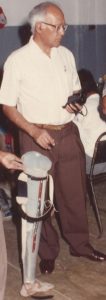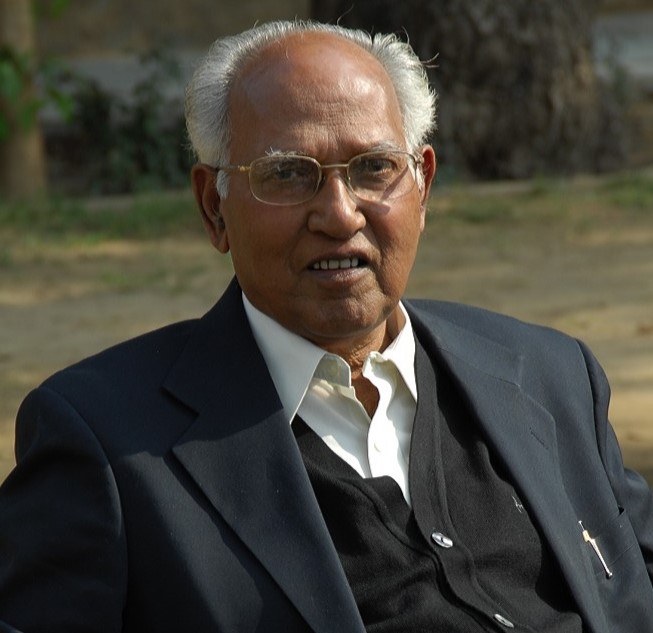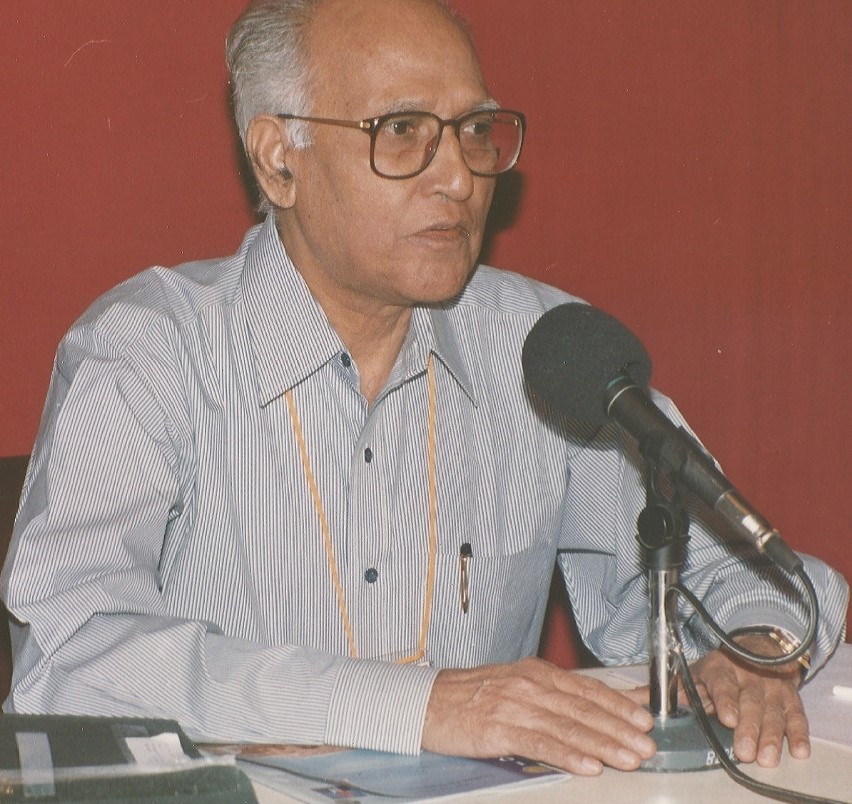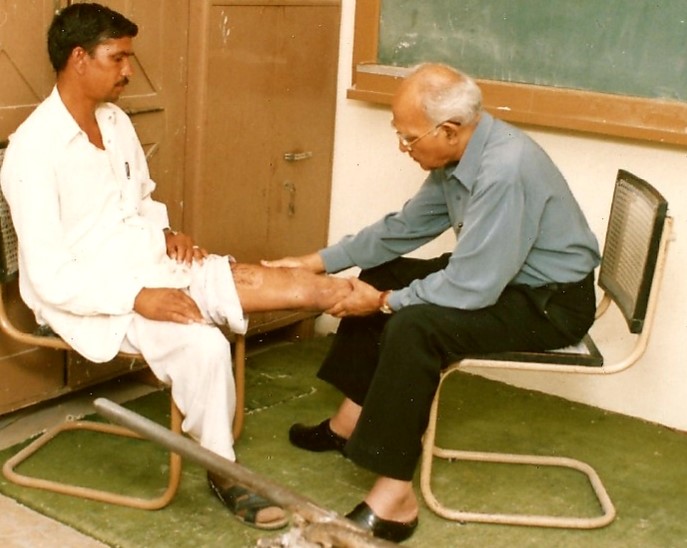By Neena Bhandari
Jaipur, 31.01.2008 (Indo Asian News Service): Each year, when I returned home from Australia for our winter sojourn, spending an evening with “uncle” – as I had come to address Dr Pramod Karan Sethi after our four-decade long association – had become a ritual. Sadly, this year I was too late. A recipient of the Padma Shri and Magasaysay awards, Sethi, who provided new hope to many an amputee with the development of an artificial limb (Jaipur Foot) in association with master artisan Ram Chander Sharma (Masterji), and improved callipers for polio patients, passed away Jan 5, 2008, at the age of 80.
Sethi and Sharma made a foot of vulcanised rubber but found it too heavy and stiff to suit the Indian lifestyle, where most chores are done by squatting on the floor. Amputees were discarding the solid-ankle-cushion-heel (SACH) feet and returning to using crutches.
 By 1970, they modified the design, filling the shell with sponge rubber and using a stiff piece for the metatarsals, adding microcellular rubber for the heel, cutting wedges at its upper end to make a universal joint.
By 1970, they modified the design, filling the shell with sponge rubber and using a stiff piece for the metatarsals, adding microcellular rubber for the heel, cutting wedges at its upper end to make a universal joint.
The modified design was more flexible, allowing the wearer to climb trees, pedal bicycles and use Indian style toilets. Sudha Chandran, in the Bollywood film “Nache Mayuri”, could perform a dance sequence wearing the Jaipur Foot.
What made the Jaipur Foot unique was its affordability and the design that could be made by a traditional craftsperson with local materials. The prosthesis, which lasts more than five years and costs about Rs.1,500, is available in over 25 countries and has given a new lease of life to many landmine victims.
The prosthesis was first used outside India for the landmine victims in Afghanistan and it continues to be in demand in Cambodia, Iraq, Kenya, Bangladesh and Nicaragua. Sharma works for the Bhagwan Mahaveer Viklang Sahayata Samiti, a charity established in 1975, which manufactures and provides the Jaipur Foot free to thousands of poor people.
The once leafy street, Vivekananda Marg, was lined mostly by doctors’ residences, including Sethi’s, and it is here that I spent my childhood with my maternal grandparents after contracting poliomyelitis.
Uncle had diagnosed my case, along with that of many other children who began pouring in at the Sawai Man Singh (SMS) hospital during that fateful month of October 1967. During those days, there was little awareness about polio in India and Oral Polio Vaccine (OPV) was imported from the former Soviet Union, but there was a snag: the cold chain, critical for maintaining the potency of OPV in transport, was very poor.
The Indian health authorities classified it as a polio epidemic, which had infected the children involved before the vaccine was administered.
My first memories of Sethi, dressed in blue denims and Kolhapuris, with young interns and doctors keeping pace during his morning rounds at the SMS Hospital in Jaipur, are still vivid.
His presence had an aura and even as a three-year-old, I knew it was time to stop mischief and start doing my physiotherapy exercises. In those days, callipers were made of straight heavy metal rods worn with big boots, which children like me hated. Must say, I was in awe of him and did fear his presence though he was always very gentle.
Many callipers on, from a doctor-patient relationship, we became friends and discussed all aspects of polio, post polio syndrome and new designs of orthotic aids using polymers and composites.
Last year I had expressed my frustration to him at being unable to find a good orthotist in Sydney. As luck would have it, I finally found a young talented orthotist, who fitted me with one of the most comfortable callipers. Alas, I was looking forward to Sethi’s input in the design.
 He was a voracious reader with an amazing memory and profound knowledge on a range of subjects. He loved nature and his knowledge of plants would put a botanist to shame.
He was a voracious reader with an amazing memory and profound knowledge on a range of subjects. He loved nature and his knowledge of plants would put a botanist to shame.
He was born in the holy city of Varanasi in November 1927 and his father was a professor of physics at the Benares Hindu University. He studied medicine in India and the United Kingdom and received many awards during his chartered career as an internationally renowned orthopaedic surgeon and inventor of the Jaipur Foot. He also received the Dr B.C. Roy Award and Rotary International’s award for world understanding and peace.
He is survived by his wife Sulochana, son and three daughters.
Uncle’s enormous contribution will continue to bring cheer to millions of physically challenged across the world.
Also read: Dr Sethi Obituary, The Lancet , Volume 371, Issue 9609, Pages 298-298
I. Oransky
© Copyright Neena Bhandari. All rights reserved. Republication, copying or using information from neenabhandari.com content is expressly prohibited without the permission of the writer and the media outlet syndicating or publishing the article.





Its great way to remember him
His clinical diagnosis was perfect. He was a great teacher and wonderful human being.
One more thing, I would like to add: Dr Pathak, who used to teach us anatomy, and Dr Sethi, both could draw with both hands at the same time and the figure drawn with left and right hands was exactly the same. Both had beautiful handwriting unlike most doctors!
One of my classmates, Dr Rakesh Bhargava, who did his MS under him, has mentioned Dr Sethi in his book `A Life Ordinary Revisited’.
Shashi Ma’am, to hear that about Papa, Dr RKPathak -was like adding fuel and flavor to my memories of Papa and Sethi uncle. Best of the pals that they were since graduation days in Agra Medical College- they had unfailing everyday company at Uncle Sethi’s home. Yes, papa was amphidextrous and had a print-like handwriting that would put me to sweat each time I compared mine with his.
What a league gone past- shall ever be remembered.
Wonderful recollection and articulation about a legend of our SMS Medical College… Dr PK Sethi was an extremely well read and cool tempered gentleman. Impeccably dressed, gentle in speech and manners he had everything about him to be emulated. His great contribution which will keep his memory alive is the unique “ Research & Rehabilitation Center”. Giving a lease of new quality of life to the patients with morbid physical disabilities, the center still stand smart, with his presence signed at every nook and corner.
Another great contribution came to Hospital from the same family… Dr KC Gangwal, the great Urologist of his times, got “Urology Research Center”. Known by his extremely humble demeanor defying his great prowess as a surgeon. DR Gangwal is the Nephew of Dr PK Sethi.